












Travel is something which interests me very much. Coming to the University of Limerick has provided me with ample opportunities to experience other cultures. Having such opportunities was one of the reasons why I decided to do my undergraduate studies here in the University of Limerick. I think that it is very important when learning a language to spend some time in the native country. It is important to become culturally aware of the language that you are learning.
During my undergraduate studies I had the chance of going abroad twice. I went to Paris for
six months in second year to work as an exchange operator in Orly Airport. I spent four months
in Vienna as an Erasmus student during my final year. Besides that I have travelled to Prague,
Brittany, Birmingham and London. Please follow the links below to take you through some of my
experiences from my travels.

For six months I lived and breathed Paris. During this period I worked in a Bureau de Change in Orly Airport. It was an experience that I will never forget. Of all the places that I have been I can easily say that it is the most magnificent city of all. For a major city I settled in there really quickly. This was partly due to my place of residence for the six months - the Irish College. This was truly a home away from home.
The Irish College is located in the Latin Quarter of the city. It remains for the most part
unknown to many Parisiens but for the Irish it is home. Irish students, like myself, take up
residence there for many months while working or studying. It is also home to many Irish
visitors who visit the city for short periods to sample its delights. I was amazed at how the
different regions of the city were in contrast with one another. The city is both old and
modern and there are no shortage of sights. Click on the links below to view some of my own
personal favourites.
 ��Tour Eiffel
��
��Tour Eiffel
�� ��Notre-Dame
��
��Notre-Dame
��  ��Arc de Triomphe
��
��Arc de Triomphe
�� ��Sacre-Coeur
��
��Sacre-Coeur
�� ��Panth�on
��Panth�on
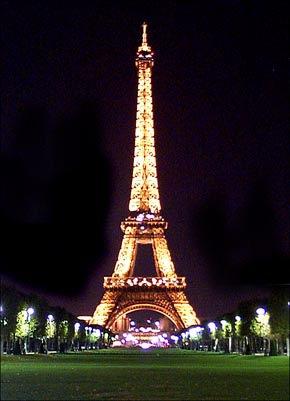
This 300-metre tower was constructed in 1889 to commemorate the centenary of the French Revolution. The controversy that once raged over this world famous tower has long since died down. In 1964 it was classified as a national monument. Its place is secure as one of the world's best-known tourist attractions.
Many people advocated its demolition but it was saved by World War 1 when it became an
important military centre for radio and telegraphic transmission. From the top of the tower it
is possible to see over 42 miles on a clear day.
Go to top of section
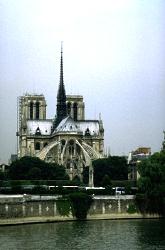
This is undoubtedly one of the world's great architectural masterpieces. What adds to the
attraction is that it was the setting for Victor Hugo's famous novel Notre-Dame de Paris
(The Hunchback of Notre-Dame). Its exterior features of gargoyles and spirals are both
beautiful and fearsome. An unusual feature of the cathedral is that its floor is absolutley
level with the street. Set into the ground just in front of the main doorway is a brass plaque
marking the Kilom�te z�ro (zero point) from which all distances from Paris are measured.
Go to top of section
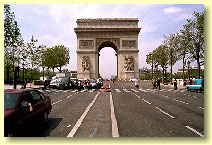
This monument is as much a symbol of Paris as the Eiffel Tower or Notre-Dame. It is the
largest structure of its kind in the world - 50 metres high and 45 metres wide. This monument
was constructed to honour all French military victories. Set into the ground under the arch is
the Tomb of the Unknown Soldier, commemorating the dead of both World Wars. Their
memory is kept alive by an eternal flame.
Go to top of section
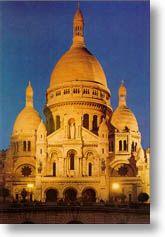
This church was built between 1875 and 1914 to honour the Sacred Heart. It wasn't consecrated
until after the war in 1919. Since 1885, there has been perpetual adoration and worship within.
The interior of the church contains one of the world's largest mosaics, and depicts Christ with
outstretched arms. The bell in the bell tower is one of the world's heaviest at 19 tons.
Go to top of section

This monument is located in the Latin Quarter at the end of the street from the Irish College.
The building of the Panth�on was ordered by Louis XV. This is the monument where the ashes of
France's great men and women, symbols of French liberty, are laid to rest. The ashes of Marie Curie
and her husband Pierre have been laid to rest here alongside Victor Hugo, Voltaire, Rousseau
and Zola.
Go to top of section
During the fourth year of my undergraduate studies I took the option of going on Erasmus for a semester. After much debate about my end destination I decided to go to Vienna. I had always wanted to see this city as I had heard so much about its beauty and culture. Thus began my four month stay in this historical city. I had chosen the best time of the year to be living in this city. During the period before Christmas the city is host to many festivals and numerous Christmas markets. The street lights and decorations are magnificent and the atmosphere is electric.
I attended the University of Vienna. My time in
Vienna was spent attending German classes, seeing the sights, enjoying the cultural life and
mixing with both natives and other foreign students. I came home with many fond memories.
I would like to share some of these with you so feel free to follow the links below.
 ��Stephansplatz ��
��Stephansplatz �� ��Staatsoper ��
��Staatsoper ��  ��Riesenrad
��
��Riesenrad
�� ��Schonbrunn
��Schonbrunn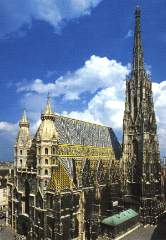
Stephansplatz is the central area of the city. It is where people meet in the caf�s, shop in
the numerous boutiques, visit the famous Stephansdom or St. Stephan's Cathedral and hang-out on
the streets. It is one main square with numerous narrow, medieval streets leading from it.
Caf�s and restaurants are plentiful here and are not too expensive. The cathedral was erected
in the square as a parish church in the first half of the 12th Century. It was destroyed during
the Second World War but reopened ceremoniously in 1948. While visiting the cathedral it is
possible to descend underground to the Katakomben, the Catacombes, which hold the remains of
members of the Hapsburg family and unidentified plague victims. I would not recommend this to
the faint-hearted.
Go to top of section
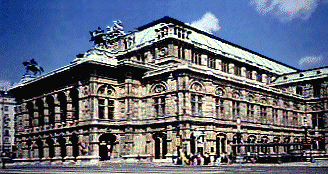
The Vienna State Opera House is an imposing piece of architecture. It has achieved legendary
status and rates as a legendary piece of pilgrimage for music lovers from all over the world.
Emperor Franz-Josef I was among the prominent guests when, in 1869, the curtain rose on the first
performance in the newly-opened State Opera House. Once every year, on the Thursday preceding
Shrove Sunday, the Opera's playbill is interrupted with a glittering event - the Vienna Opera
Ball. This is the star-studded climax of the ball season.
Go to top of section
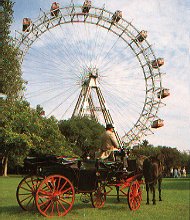
The Riesenrad, or Giant Ferris Wheel, belongs to the landmarks of Vienna and is a symbol of
the world-famous Pr�ter amusement park. Rising above the roofs of the city it attracts visitors
from far and wide. It was built by the English engineer Walter B. Bassett in 1896/97. He had
built others in London, Blackpool and Paris but these were later demolished. In all, the Ferris
Wheel has 15 cabins and has been fully operational since 1947. Besides the Ferris Wheel there
are countless other amusements for all ages. It is a lovely day out for all the family but
the rides themselves are fairly expensive.
Go to top of section
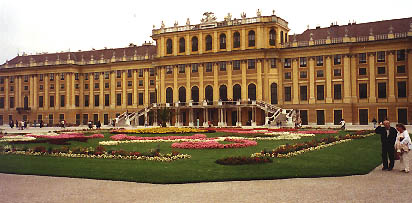
This is a must for anyone interested in historical and cultural buildings. This palace was
the former summer home of the Hapsburg emperors. It is an amazing sight during the lead up to
Christmas and even holds a Christmas market on the grounds. The palace has 1,441 rooms
and halls. There are countless gardens on the grounds containing baroque fountains and
sculptures. In the distance one can see the Gloriette, a small Colonnade
crowning a hill on the palace grounds. The palace grounds are also home to the world's oldest
zoo containing 760 different species of animals.
Go to top of page


